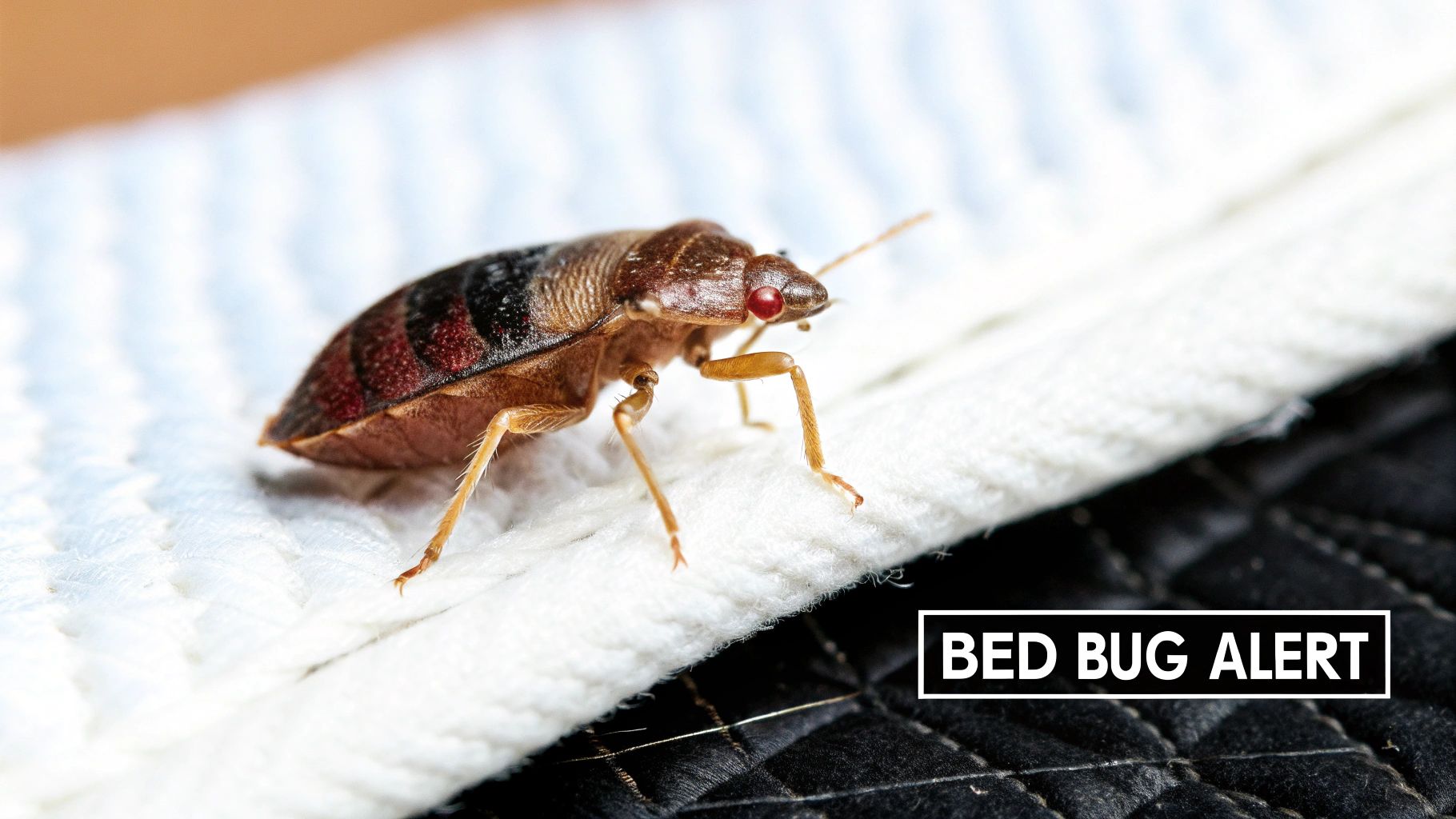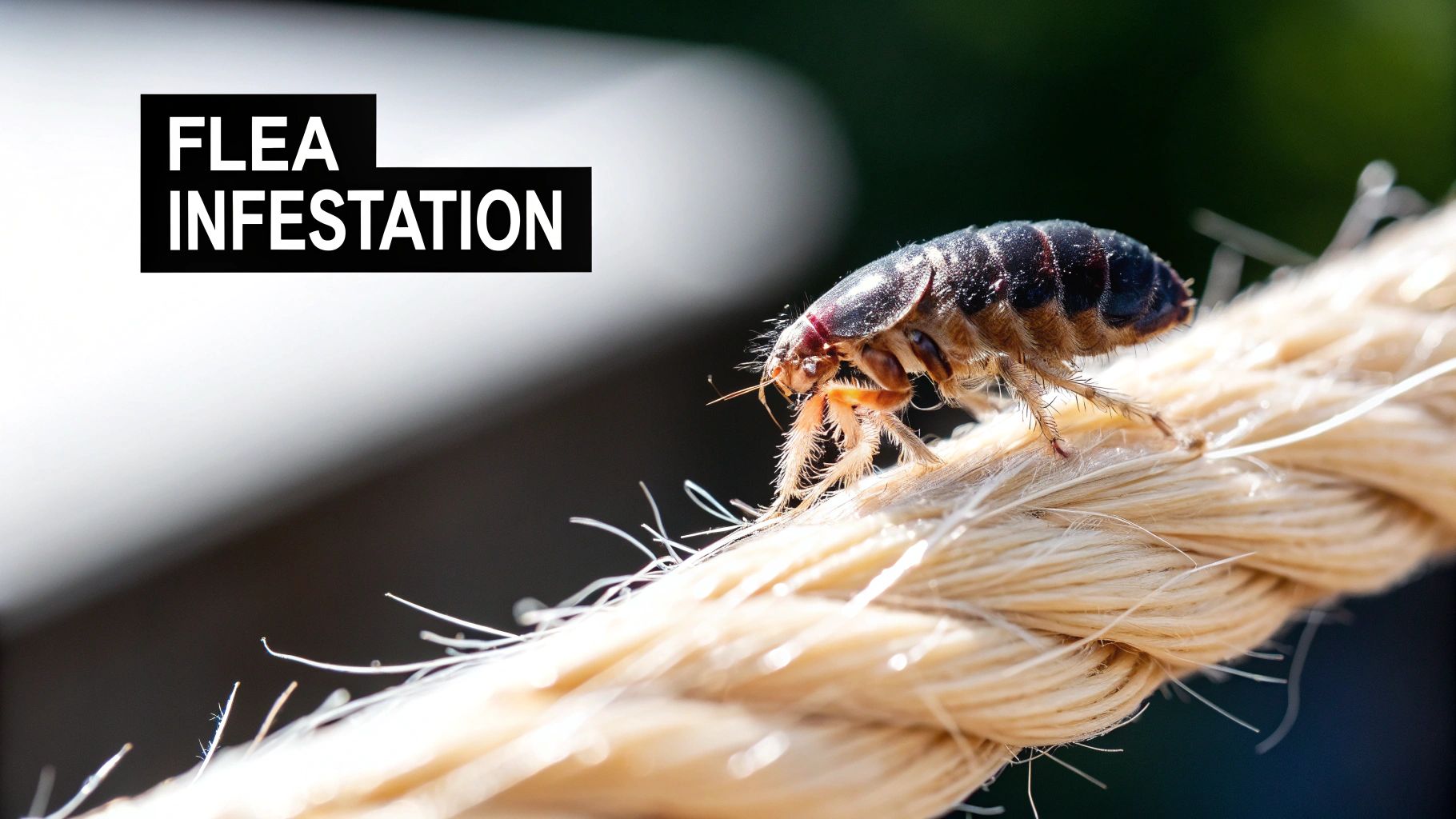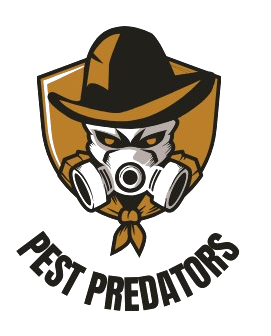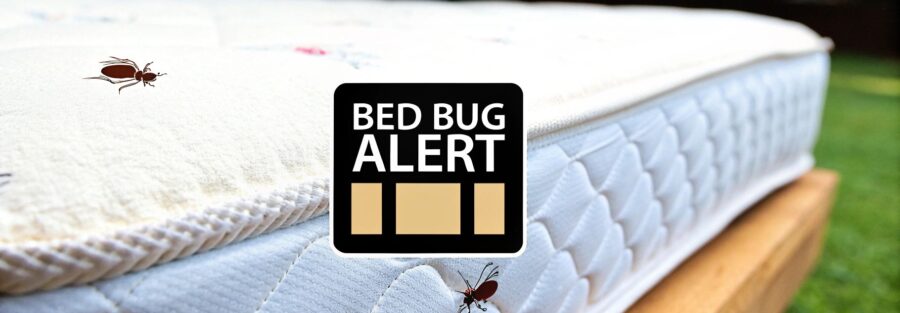That unsettling feeling of sharing your personal sanctuary with unwanted guests is something no one wants to experience. While bed bugs often take the spotlight, a surprising variety of other pests can make their home in your mattress, bedding, and bedroom furniture. Understanding the different types of bugs in beds is the first critical step towards reclaiming your peace of mind and ensuring a healthy sleeping environment. This is more than just an inconvenience; a pest-free bed is fundamental to your physical health and overall wellbeing.
This comprehensive guide will walk you through the eight most common culprits you might find lurking in your bedroom. From the infamous blood-feeders and their itchy bites to microscopic allergy triggers and fabric-destroying larvae, we provide the expert knowledge you need to identify, prevent, and tackle any infestation effectively. We will delve into their distinct habits, the specific risks they pose, and most importantly, offer actionable, science-backed advice to keep your bed a bug-free zone. Prepare to move beyond guesswork and arm yourself with practical strategies for maintaining a clean, safe, and truly restful space.
1. Bed Bugs
Topping the list of infamous types of bugs in beds, bed bugs (Cimex lectularius) are the quintessential nocturnal pests that homeowners dread. These small, reddish-brown parasitic insects are oval-shaped and flat, allowing them to hide in the tiniest cracks and crevices. They feed exclusively on blood, preferring human hosts, and emerge from their hiding spots at night to feed while you are asleep.

The primary issue with bed bugs is their incredible resilience and ability to spread. An infestation often starts small, perhaps from a single pregnant female hitching a ride in your luggage from a hotel, or arriving hidden inside a piece of second-hand furniture. From there, they can quickly multiply, infesting mattresses, bed frames, skirting boards, and even electrical outlets. In multi-unit buildings like apartment blocks or student halls, they can easily travel between flats through wall voids and shared plumbing.
Signs and Prevention Strategies
Identifying an infestation early is key. Look for tell-tale signs such as small, dark faecal spots on your mattress seams, shed skins, or the bugs themselves. Bites often appear as itchy red welts, frequently in a line or cluster on exposed skin.
Proactive prevention is the most effective defence:
- Travel Smart: When staying in hotels, thoroughly inspect the mattress, headboard, and nearby furniture before unpacking. Using hard-shell luggage can also make it more difficult for bed bugs to latch on.
- Post-Travel Protocol: After a trip, wash all clothing in hot water and dry on high heat immediately upon returning home, even items you didn't wear.
- Secure Your Sleep Area: Invest in high-quality mattress and box spring encasements. These zippered covers trap any existing bugs and prevent new ones from infesting your bed.
- Regular Maintenance: Vacuum your bedroom frequently, paying close attention to the mattress, carpet edges, and furniture. Sealing any cracks or crevices in walls and around skirting boards can eliminate potential hiding spots.
For a visual guide on what to look for, the following video offers a detailed look at bed bug identification:
2. Dust Mites
Unlike bed bugs, dust mites (Dermatophagoides pteronyssinus) are microscopic arachnids that are invisible to the naked eye. These types of bugs in beds don't bite or feed on blood; instead, they thrive on the dead skin cells that humans and pets shed daily. A typical mattress can be home to millions of them, particularly in warm, humid environments where they can multiply rapidly. They are a primary cause of indoor allergies and asthma symptoms.
The problem with dust mites isn't the creatures themselves but the allergenic proteins found in their faecal matter and decaying bodies. When these microscopic particles become airborne-often disturbed by activities like making the bed or vacuuming-they can be inhaled, triggering allergic reactions. Symptoms can range from sneezing and a runny nose to more severe asthma attacks, making their control crucial for a healthy sleeping environment, especially in children's bedrooms or for anyone with respiratory sensitivities.
Signs and Prevention Strategies
Since dust mites are invisible, you won’t see them. Instead, you'll notice the allergic reactions they cause, such as persistent sneezing, itchy eyes, a stuffy nose (especially in the morning), or worsening asthma. Controlling their population requires a consistent, multi-faceted approach focused on cleaning and managing their environment.
Proactive prevention is the best way to manage dust mite populations:
- Wash Bedding Frequently: Launder all sheets, pillowcases, and blankets weekly in water that is at least 60°C to kill dust mites and wash away allergens.
- Encase Your Bed: Use allergen-proof, zippered covers for your mattress, pillows, and duvet. These create a barrier that prevents mites from colonising your bedding.
- Control Humidity: Maintain a relative humidity level below 50% in your home using a dehumidifier or air conditioning. Dust mites cannot survive in dry conditions.
- Choose Bedding Wisely: Opt for synthetic bedding materials over feather or down, which can trap more allergens. Replace pillows every one to two years.
- Improve Cleaning Habits: Vacuum mattresses and carpets regularly with a vacuum cleaner equipped with a HEPA filter to trap fine particles. Wiping surfaces with a damp cloth is more effective than dry dusting.
The following infographic illustrates a simple, effective process for minimising dust mites in the bedroom.

This step-by-step process highlights how combining regular hot-water washing with physical barriers and environmental control creates a comprehensive defence against these microscopic pests.
3. Fleas
While often associated with pets, fleas (Siphonaptera) are another common type of bug found in beds, especially in households with cats or dogs. These tiny, wingless parasites are reddish-brown and laterally compressed, allowing them to move effortlessly through fur and carpet fibres. They feed on the blood of mammals and are renowned for their powerful legs, which enable them to jump impressive distances to find a host.

A flea infestation typically starts when a pet brings them into the home from outdoors. However, even homes without pets can be at risk, especially if a previous tenant had animals. Once inside, fleas lay their eggs in carpets, pet bedding, and upholstered furniture. These eggs hatch into larvae that feed on organic debris before pupating and emerging as adult fleas, ready to jump onto a new host, which could easily be a person sleeping in their bed. Their bites cause intense itching and can lead to skin infections or allergic reactions.
Signs and Prevention Strategies
Identifying fleas involves looking for the insects themselves, which are often fast-moving, or their droppings, known as "flea dirt". This looks like tiny black specks and will turn red if a drop of water is added. Bites on humans are usually small, red bumps, typically found in clusters around the ankles and lower legs.
A proactive approach is crucial to keep your home flea-free:
- Treat Your Pets: Regularly use a veterinarian-approved flea control treatment for all household pets. This is the single most effective step in preventing an infestation from starting.
- Vigorous Cleaning: Vacuum carpets, rugs, and furniture frequently, paying special attention to areas where pets rest. After vacuuming, immediately seal the bag and dispose of it in an outside bin.
- Wash Bedding Regularly: Wash all human and pet bedding in hot water and dry on the highest heat setting to kill fleas at all life stages.
- Maintain Your Garden: Keep your garden tidy and grass short to reduce flea habitats outdoors, making it less likely for pets to bring them inside.
For those interested in managing an infestation with fewer chemicals, you can explore various options for a natural flea treatment. In cases of a severe infestation, contacting a professional pest control service is the most reliable solution.
4. Carpet Beetles
While not as infamous as bed bugs, carpet beetles (Anthrenus species) are a surprisingly common type of bug found in beds, causing damage in a different way. The adult beetles are small, oval-shaped, and often have a mottled pattern of white, brown, and black. However, it’s not the adults that are the problem, but their larvae. These tiny, hairy, caterpillar-like larvae feed on natural animal fibres like wool, silk, feathers, and leather.
The primary issue with carpet beetle larvae is their destructive appetite for items found in and around the bedroom. An infestation can lead to significant damage to woollen blankets, silk sheets, down-filled duvets, and upholstered furniture. Unlike bed bugs, they don't bite humans, but the larvae's bristly hairs can cause an itchy, rash-like reaction in sensitive individuals, which is often mistaken for insect bites. Adult beetles are often found near windows as they are attracted to light, which can be a clue that an infestation is present.
Signs and Prevention Strategies
Identifying a carpet beetle problem involves looking for the larvae and the damage they leave behind. You might find their shed, bristly skins under furniture or along skirting boards, or discover irregular holes in your natural fibre textiles.
Proactive prevention is the best way to protect your belongings:
- Vigilant Cleaning: Vacuum carpets, rugs, and upholstered furniture frequently and thoroughly. Pay special attention to the edges of rooms, underneath furniture, and inside wardrobes where dust and fibres accumulate.
- Secure Storage: Store out-of-season natural fibre items, such as woollen jumpers or silk bedding, in airtight bags or sealed plastic containers. Before storing, ensure items are professionally dry-cleaned.
- Natural Repellents: Use cedar blocks or lavender sachets in wardrobes and drawers. The scent of these natural repellents can deter adult beetles from laying their eggs nearby.
- Seal Entry Points: Adult carpet beetles often fly in from outdoors. Check window screens for damage and seal any cracks or gaps around window frames, doors, and utility pipes to block their entry.
For a closer look at what carpet beetle larvae look like and the signs of their presence, this video provides helpful visual information:
5. Spider Beetles
Often mistaken for small spiders due to their long antennae and rounded, globular bodies, spider beetles (Ptininae subfamily) are scavenger pests that can find their way into our sleeping quarters. These small, reddish-brown to black insects are not parasitic and do not bite humans. Instead, they are attracted to a wide variety of dried organic materials, making them a common nuisance in pantries, warehouses, and occasionally, bedrooms.
The primary problem with spider beetles is their ability to infest stored goods and create an unsettling presence. An infestation in a bedroom might stem from crumbs left from snacking in bed, stored pet food nearby, or even from organic debris like dead insects or animal nests within wall voids or loft spaces. They are nocturnal, so you are most likely to spot them crawling on walls or floors at night as they search for food, making them another of the unwelcome types of bugs in beds and surrounding areas.
Signs and Prevention Strategies
Identifying a spider beetle issue usually involves spotting the adult beetles themselves or finding contaminated food sources with signs of damage. Because they are scavengers, their presence points to an underlying source of food that needs to be removed.
Keeping your bedroom free of these pests involves eliminating their food supply:
- Remove Food Sources: Avoid eating in bed and ensure no crumbs or food spillages are left behind. If you store pet food nearby, make sure it is kept in airtight, sealed containers.
- Seal Entry Points: Thoroughly inspect your room for any cracks, crevices, or gaps in skirting boards, walls, and around window frames. Sealing these eliminates potential hiding spots and entry routes.
- Maintain Cleanliness: Regularly vacuum your bedroom, paying close attention to corners, underneath furniture, and inside wardrobes. This removes potential food sources like dust, hair, and dead insects.
- Control Humidity: Spider beetles thrive in damp conditions. Use dehumidifiers in poorly ventilated areas and fix any leaks promptly to make the environment less hospitable for them.
While spider beetles are distinct from arachnids, understanding how to manage household pests is crucial. For information on a more commonly known eight-legged intruder, you can learn more about dealing with a UK spider infestation.
6. Book Lice (Psocids)
Though their name might suggest a literary diet, book lice (Psocoptera) are not lice and do not actually feed on books. These minuscule, soft-bodied insects are drawn to high-humidity environments where they feed on mould and fungi. This makes them one of the more unusual types of bugs in beds, often appearing in damp bedrooms, particularly those in basements or areas with poor ventilation.
The primary issue with book lice is what their presence signifies: an underlying moisture problem. They thrive in humidity levels above 60%, feeding on the microscopic mould that grows on starchy materials like wallpaper glue, book bindings, and even dust. While they do not bite and are generally harmless to humans, a significant population indicates that your bedroom environment is damp enough to support mould growth, which can have its own health implications.
Signs and Prevention Strategies
Identifying book lice can be tricky due to their tiny size (1-2 mm) and translucent appearance. You might spot these fast-moving specks on walls, near window sills, or around stored papers and books. The key to eliminating them is not through insecticides but by controlling the environment that allows them to flourish.
Proactive moisture control is the most effective defence:
- Reduce Humidity: Use dehumidifiers to maintain indoor humidity below 50%. This is the single most important step, as it removes the mould they need to survive.
- Improve Ventilation: Increase air circulation by opening windows regularly or using fans, especially in stuffy or basement bedrooms. Ensure bathroom and kitchen extractor fans are functioning correctly.
- Remove Food Sources: Discard any mouldy or damp books, papers, or cardboard. Thoroughly clean areas where you've seen mould, using an appropriate mould-killing solution.
- Repair Leaks: Inspect your home for and promptly repair any sources of moisture, such as leaking pipes, faulty window seals, or roof damage, to prevent damp from building up.
For a closer look at these tiny pests, the following video provides detailed footage of book lice in action:
7. Clothes Moths
While not parasites that bite humans, clothes moths (Tineola bisselliella and Tinea pellionella) are another type of bug found in beds and bedrooms that cause a different kind of problem. These small, golden-coloured moths are not the source of damage themselves; rather, it is their larvae that feed on natural fibres. They are particularly drawn to materials like wool, cashmere, silk, fur, and cotton blends, making your bedding, carpets, and stored clothing a potential feast.
The primary issue with clothes moths is the destructive, often unnoticed, activity of their larvae. Adult moths are weak flyers and tend to stay close to infested areas, like wardrobes and under beds, but they do not eat fabric. They lay their eggs on suitable materials, and the emerging larvae munch away, creating holes in valuable items like woollen blankets, heirloom quilts, and expensive clothing. An infestation can begin from an item brought into the home or from moths flying in through an open window, quickly establishing a breeding ground in dark, undisturbed areas.
Signs and Prevention Strategies
Identifying a clothes moth problem involves looking for more than just the adult moths. Watch for small holes in fabrics, silken webbing or tubes on materials, or the tiny, cream-coloured larvae themselves. You may also find shed larval casings in drawers or at the bottom of wardrobes.
Proactive prevention is crucial to protect your belongings:
- Store Items Properly: Before storing seasonal bedding or clothing, ensure they are thoroughly cleaned. Store them in airtight vacuum-sealed bags or plastic containers.
- Use Natural Repellents: Place cedar blocks, sachets of lavender, or rosemary in your wardrobes and drawers. The scent is a natural deterrent for adult moths.
- Maintain a Clean Environment: Vacuum regularly, especially under beds, inside wardrobes, and along skirting boards to remove dust, hair, and fibres that can attract moths and harbour larvae.
- Inspect and Rotate: Periodically check items that are stored away, shaking them out in the daylight. This disturbance can disrupt the moth life cycle and help you spot an issue early.
For a comprehensive guide on tackling these fabric pests, you can learn more about professional textile pest control.
For a visual guide on what to look for, the following video offers a detailed look at clothes moth identification:
8. Cockroach Nymphs
While adult cockroaches are an alarming sight anywhere in a home, finding their young, known as nymphs, in your bedroom is a particularly troubling sign. Cockroach nymphs are smaller, wingless versions of adults that signal a nearby and actively breeding infestation. They seek out dark, sheltered spaces with access to food and moisture, and while less common than in kitchens, bedrooms can provide ideal harbourage, especially if food is consumed there.

The presence of nymphs is a serious red flag because it confirms that cockroaches are not just passing through but have established a nest. This is common in properties with persistent moisture issues, such as a bedroom adjoining a bathroom with a leaky pipe, or in multi-unit buildings like apartment blocks where infestations can spread through shared walls and plumbing. Nymphs shed their skins as they grow, and this, along with their droppings, can trigger allergies and asthma, making their elimination crucial for maintaining a healthy living environment.
Signs and Prevention Strategies
Identifying cockroach nymphs requires a keen eye. Look for small, dark specks that resemble coffee grounds or black pepper (their faeces), tiny shed skins, or a musty, oily odour in the room. You may also spot the nymphs themselves scurrying for cover when a light is turned on.
Effective prevention focuses on making your bedroom inhospitable:
- Eliminate Food and Water: Enforce a strict no-food-in-the-bedroom policy. Ensure there are no leaks from adjoining bathrooms or radiators, as cockroaches need water to survive.
- Seal Entry Points: Thoroughly inspect and seal any cracks in walls, gaps around skirting boards, and openings around pipes or electrical outlets to block their travel routes.
- Remove Clutter: Keep your bedroom tidy and organised. Piles of clothes, boxes, and other clutter provide the perfect dark, undisturbed hiding spots for nymphs to thrive.
- Professional Intervention: A nymph sighting indicates a larger problem that often requires professional help. Pest control experts can use targeted treatments like gel baits and insect growth regulators to eradicate the entire nest.
Types of Bed Bugs Comparison Table
| Pest Type | Implementation Complexity 🔄 | Resource Requirements ⚡ | Expected Outcomes 📊 | Ideal Use Cases 💡 | Key Advantages ⭐ |
|---|---|---|---|---|---|
| Bed Bugs | High – professional treatment often needed | High – pest control services and encasements | Effective elimination but costly | Hotels, apartments, dormitories; infestations requiring expert intervention | Well-established treatment methods; easy identification once infestation is visible |
| Dust Mites | Medium – ongoing environmental control needed | Moderate – allergen-proof covers, dehumidifiers | Reduced allergy symptoms over time | Bedrooms with allergy sufferers; humid climates | Manageable via maintenance; no biting or direct harm |
| Fleas | Medium to High – need synchronized pet and environment treatment | Moderate to High – vet treatments, cleaning | Control of infestation with integrated methods | Homes with pets, especially cats and dogs | Visible adult stage; effective treatments available |
| Carpet Beetles | Medium – focused on cleaning and storage practices | Low to Moderate – vacuuming, storage containers | Damage reduction and prevention | Homes with natural fiber textiles, vintage items | Adults harmless; larvae damage targetable through storage care |
| Spider Beetles | Low to Medium – sanitation and monitoring | Low – cleaning, sticky traps | Manageable contamination and infestations | Bedrooms with stored food or organic debris | Easy to remove; no biting or structural damage |
| Book Lice | Low – humidity and mold control | Low – dehumidifiers, ventilation | Reduced populations and moisture issues | Humid bedrooms, basements, paper storage areas | Indicate moisture problems; easy to control with humidity |
| Clothes Moths | Medium – prevention via storage and traps | Moderate – cedar, pheromones, storage solutions | Prevent fabric damage, intermittent infestations | Closets and storage with natural fibers | Visible adults; preventable damage without harsh chemicals |
| Cockroach Nymphs | High – thorough sanitation and professional help | High – baits, professional pest control | Rapid reduction of growing infestations | Infested apartments, homes near kitchens | Early infestation indicator; easier to eliminate than adults |
Taking Control: Your Next Steps to a Pest-Free Bedroom
Navigating the world of unwelcome bedroom intruders can be unsettling, but knowledge is the first and most powerful line of defence. This guide has equipped you with the ability to distinguish between the notorious bed bug and less obvious culprits like carpet beetles, spider beetles, and even book lice. By understanding the distinct habits, life cycles, and risks associated with each of these types of bugs in beds, you've taken a crucial step towards reclaiming your sanctuary.
Remember, the core principle of pest control is proactive prevention, not just reactive treatment. Many of the pests we've discussed, from dust mites to clothes moths, thrive in specific environmental conditions. Your greatest takeaway should be the power you hold to disrupt these conditions.
From Knowledge to Action: Your Preventative Checklist
The journey from identifying a pest to ensuring it never returns is paved with consistent habits. While each insect has unique vulnerabilities, several overarching strategies form a robust defence against nearly all of them:
- Mastering Moisture: Control humidity levels with dehumidifiers and proper ventilation. This single action creates an inhospitable environment for dust mites, book lice, and cockroaches, all of which depend on damp conditions to flourish.
- Declutter and Deep Clean: A minimalist and meticulously clean environment offers fewer hiding places and food sources. Regularly vacuuming carpets, upholstery, and mattresses, paying special attention to crevices and seams, is non-negotiable. This directly combats fleas, carpet beetles, and bed bugs.
- Vigilant Inspections: Cultivate a habit of inspecting items before they cross your threshold. Second-hand furniture, library books, and even luggage returning from a trip can be Trojan horses for pests like bed bugs and spider beetles.
- Proper Storage: Store fabrics, especially natural fibres like wool and silk, in sealed, airtight containers. This preventative measure is your best weapon against the destructive larvae of clothes moths.
When to Escalate to Professional Intervention
While diligent housekeeping can manage or prevent many issues, some infestations are simply too resilient, too widespread, or too hazardous to tackle alone. Bed bugs, with their infamous hiding skills and resistance to many treatments, and cockroaches, with their rapid breeding and potential to spread disease, often fall into this category.
Attempting DIY treatments for these stubborn pests can sometimes worsen the problem, scattering them to other areas of your home and leading to prolonged stress and expense. Recognising when you are out of your depth is not a defeat; it is a strategic decision to protect your home and well-being. Professional pest controllers possess the expertise, specialised equipment, and access to regulated treatments that are far more effective and safer than over-the-counter options. They don't just eliminate the pests you see; they target the entire life cycle, from egg to adult, ensuring complete eradication and preventing a swift re-infestation.
Ultimately, your bedroom should be a place of rest and rejuvenation, free from the anxiety that pests can cause. By applying the preventative strategies outlined here and knowing when to call for expert help, you can ensure your sleeping space remains a true haven.
Are you facing a persistent pest problem or need expert advice on identifying the specific types of bugs in beds in your property? Contact Pest Predators Limited for a professional consultation with a qualified Field Biologist. We provide evidence-based, effective solutions tailored to your unique situation, ensuring your home is secure and pest-free. Pest Predators Limited



